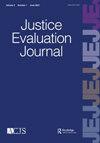Body-Worn Cameras and Settlements
IF 0.7
Q3 CRIMINOLOGY & PENOLOGY
引用次数: 0
Abstract
AbstractBody-worn cameras (BWCs) have been widely adopted in the United States due to their perceived promise of reducing police misconduct through a deterrent or Hawthorne effect. Much of the available evidence indicates that BWCs reduce civilian complaints, use-of-force, and other police misbehavior. However, there is a tendency for existing research to study minor forms of misbehavior rather than serious misconduct. This study focuses on examining how settlements, a proxy of serious police misconduct, changed with BWC adoption and are an important outcome to study as they may correspond with financial and litigation burdens for police departments. This study uses panel data from 19 police departments over 10 years to assess how settlements changed post-BWC adoption. The results indicate BWC adoption is associated with a 40% reduction in police settlements and a 40% decrease in the median cost per settlement, and suggest BWCs may lead to less severe police misconduct over time.Keywords: Body-worn camerascivil litigationlaw enforcementpolice accountabilitypolice misconduct Disclosure statementNo potential conflict of interest was reported by the author(s)Notes1 Four agencies (Fairfax County [VA], Orange Counties [CA, FL], Palm Beach County [FL], and Riverside County [CA]) were excluded from the study because they did not indicate the year of disbursement. New York was not selected for the paper because their number of payments was 23 times higher than the next highest agency (i.e., New York is an influential outlier).2 A few agencies do not report dates for settlements so the counts for some agencies are artificially deflated. The affected agencies include: Detroit (66 settlements); Indianapolis (four settlements); Phoenix (two settlements); Portland (three settlements). Atlanta does not report settlement data for 2010-2013 so those observations are recorded as missing.3 Linear interpolation was accomplished by filling in missing values between pre-deployment (0) years and post-deployment (1) years as a function of time to model partial deployment (e.g., .2, .4, .6, etc.). This strategy was used as many agencies adopted BWCs over time.4 Jacksonville (FL), Indianapolis (IN), and Prince George's County (MD) fully adopted BWC after 2019 so their adoption is modeled as partial when applicable.5 Phoenix (AZ) and Minneapolis (MN) were targeted for investigation in 2021. Detroit (MI), Los Angeles (CA), Prince George's County (MD), and Washington D.C. completed their consent decree before or during the study period. Baltimore (MD), Chicago (IL), Cleveland (OH), Miami (FL), Portland (OR), and Seattle (WA) fell under DOJ oversight during the study period or completed their consent decree outside of the study period).6 The number of officers is used as an exposure term in the total number of suits model. In the median amount models, the officer rate per 1,000 people is used as a control variable.7 For a follow-up analysis, BWC adoption was modeled as a three-point categorical variable to represent pre-adoption (0), partial deployment (1), and full deployment (2). The results from this analysis align with those presented in the paper.Additional informationNotes on contributorsZachary A. PowellZachary A. Powell is an associate professor in the School of Criminology and Criminal Justice at California State University, San Bernardino. Powell’s work focuses on a variety of police accountability issues. His work has been published in Criminology and Public Policy, Policing: A Journal of Policy and Practice, and Social Forces.随身相机和定居点
摘要随身摄像机(BWCs)在美国被广泛采用,因为人们认为它们有望通过威慑或霍桑效应减少警察的不当行为。许多现有证据表明,生化武器减少了平民投诉、使用武力和其他警察不当行为。然而,现有的研究倾向于研究轻微的不当行为,而不是严重的不当行为。本研究的重点是研究和解(严重警察不当行为的代表)如何随着《禁止生物武器公约》的采用而改变,这是一个重要的研究结果,因为它们可能与警察部门的财政和诉讼负担相对应。这项研究使用了19个警察部门10年来的面板数据来评估采用《禁止生物武器公约》后居住区的变化。研究结果表明,生物武器的采用与警察和解减少40%和每次和解中位数成本降低40%有关,并表明随着时间的推移,生物武器可能会减少严重的警察不当行为。关键词:随身摄像机民事诉讼执法警察问责警察不当行为披露声明作者未报告潜在的利益冲突注1四个机构(费尔法克斯县[弗吉尼亚州],奥兰治县[加利福尼亚州,佛罗里达州],棕榈滩县[佛罗里达州]和河滨县[加利福尼亚州])因未指明支付年份而被排除在研究之外。纽约之所以没有被选中,是因为他们的支付数量是排名第二的机构的23倍(也就是说,纽约是一个有影响力的异常值)一些机构不报告结算日期,因此一些机构的统计数字被人为地压低了。受影响的机构包括:底特律(66个定居点);印第安纳波利斯(四个定居点);凤凰城(两个定居点);波特兰(三个定居点)。亚特兰大没有报告2010-2013年的定居点数据,因此这些观察结果被记录为失踪线性插值是通过填充部署前(0)年和部署后(1)年之间的缺失值来完成的,作为时间的函数来建模部分部署(例如,0.2、0.4、0.6等)。随着时间的推移,许多机构采用了生物武器公约,因此采用了这一战略杰克逊维尔(FL)、印第安纳波利斯(IN)和乔治王子县(MD)在2019年之后完全采用了生物武器公约,因此它们的采用在适用时被建模为部分采用菲尼克斯(亚利桑那州)和明尼阿波利斯(明尼苏达州)是2021年的调查目标。底特律(MI)、洛杉矶(CA)、乔治王子县(MD)和华盛顿特区在研究之前或研究期间完成了他们的同意令。巴尔的摩(MD)、芝加哥(IL)、克利夫兰(OH)、迈阿密(FL)、波特兰(OR)和西雅图(WA)在研究期间处于美国司法部的监管之下,或在研究期间之外完成了他们的同意令在总服数模型中,军官人数作为暴露项。在中位数模型中,每1,000人的官员率被用作控制变量对于后续分析,生物武器的采用被建模为一个三点分类变量,分别表示预采用(0)、部分部署(1)和完全部署(2)。该分析的结果与本文中提出的结果一致。本文作者zachary A. Powell是位于圣贝纳迪诺的加州州立大学犯罪学和刑事司法学院的副教授。鲍威尔的工作重点是各种警察问责问题。他的作品发表在《犯罪学与公共政策》、《警务:政策与实践杂志》和《社会力量》等刊物上。
本文章由计算机程序翻译,如有差异,请以英文原文为准。
求助全文
约1分钟内获得全文
求助全文

 求助内容:
求助内容: 应助结果提醒方式:
应助结果提醒方式:


